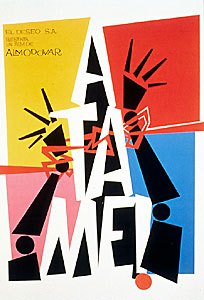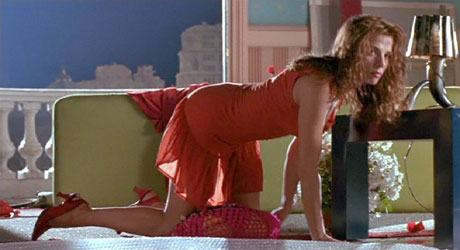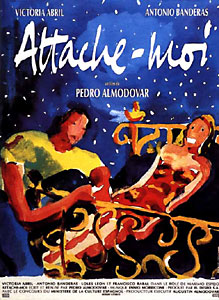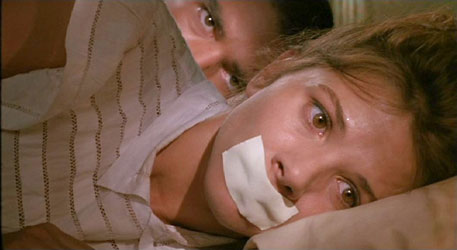|
|
|
|
|
 |
 |
|
| |
¡Átame!
(Tie Me Up, Tie Me Down! | Fessle mich! | Attache-moi !)
|
|
|
| |
 |
España 1990 | 111 min
Director: Pedro Almodóvar
Producer: Enrique Posner
Production Company: El Deseo S.A.
Screenplay: Pedro Almodóvar, Yuyi Beringola
Cinematography: José Luis Alcaine (Eastmancolor, 1.85:1 Widescreen 35 mm)
Editor: José Salcedo
Music Score: Ennio Morricone
Canciones: Pedro Almodóvar, Bernardo Bonezzi, Manuel de la Calva, Jacob Gade, Rafael Hernández, Carlos Toro Montoro, Fabio de Miguel
Sound: Francisco Peramos (Dolby Stereo)
Production Design: Esther Garcia
Set Design: Ferrán Sánchez
Locations: Estudios Barajas S.A.; Tres Cantos S.A.
Cast: Victoria Abril (Marina Osorio), Antonio Banderas (Ricky), Loles León (Lola), Francisco Rabal (Máximo Espejo), Julieta Serrano (Alma), María Barranco (Berta), Rossy de Palma ("Camello")
Release: 22 Jan 1990 (premiere Spain) | 16 Aug 1990 (Germany)
Awards: Berlin International Film Festival 1990, nominated Golden Bear
|

|
|
 International Movie Database International Movie Database |
 All-Movie Guide All-Movie Guide |
|
|
| |
 |
|
| |
 "I'll never love you ... ever!" the sexy and attractive Marina (Victoria Abril) states emphatically to the love-struck Ricky (Antonio Banderas). You know she means what she says because when she makes this statement she is handcuffed and lashed to a bed, not exactly the proper way to warm anyone up for romance. Yet in Pedro Almodóvar's Tie Me Up! Tie Me Down! the way to a woman's heart is depicted as being held in captivity until the Stockholm Syndrome kicks in. The film concerns the plight of Marina, a "B"-movie diva trying to adjust to her recent success after years of porno films and drug addiction. But then into her life comes Ricky, a part-time handyman and full-time mental patient, who, during one of his past escapes from the mental ward, had spent the night with Marina — who gave in to him during one of her less-discerning moments. Since then, Ricky has been thinking of her constantly. Determined to win her affections, he kidnaps Marina, holding her captive in her own apartment and trying everything to convince her to love him — then they could marry and have a big family. All Ricky's attempts to woo Marina fail. Finally, after taking a severe beating from some street thugs, he strikes a chord in Marina's nurturing heart so that when her sister Lola (Loles Leon) finally discovers her plight, Marina no longer wants to be rescued. "I'll never love you ... ever!" the sexy and attractive Marina (Victoria Abril) states emphatically to the love-struck Ricky (Antonio Banderas). You know she means what she says because when she makes this statement she is handcuffed and lashed to a bed, not exactly the proper way to warm anyone up for romance. Yet in Pedro Almodóvar's Tie Me Up! Tie Me Down! the way to a woman's heart is depicted as being held in captivity until the Stockholm Syndrome kicks in. The film concerns the plight of Marina, a "B"-movie diva trying to adjust to her recent success after years of porno films and drug addiction. But then into her life comes Ricky, a part-time handyman and full-time mental patient, who, during one of his past escapes from the mental ward, had spent the night with Marina — who gave in to him during one of her less-discerning moments. Since then, Ricky has been thinking of her constantly. Determined to win her affections, he kidnaps Marina, holding her captive in her own apartment and trying everything to convince her to love him — then they could marry and have a big family. All Ricky's attempts to woo Marina fail. Finally, after taking a severe beating from some street thugs, he strikes a chord in Marina's nurturing heart so that when her sister Lola (Loles Leon) finally discovers her plight, Marina no longer wants to be rescued.
Ein aus der Anstalt entlassener Psychopath und eine ehemalige Pornodarstellerin: Ricky beobachtet Marina im Studio während der Dreharbeiten zu einem Horrorfilm, später dringt er in ihre Wohnung ein, überwältigt und fesselt sie — nicht etwa, um ihr ein Leid zuzufügen, sondern um ihre Liebe zu gewinnen: "Ich möchte dir ein guter Ehemann sein und ein guter Vater für deine Kinder!" Dass sie vor Jahren mit ihm einen One-Night-Stand verbracht hat, mag seine Motivation erklären; dass sie nach der Befreiung durch ihre Schwester Lola zu ihrem Peiniger zurückkehrt und in die Ehe einwilligt, macht die Story vollends grotesk. Nur hat die Groteske ihre eigene Logik, und diese stellt das gewohnte Verhältnis normal/anormal dergestalt auf den Kopf, dass Lolas Frage "Wie kannst du einen Mann wollen, der dich überfällt und ans Bett fesselt?" schließlich eine überzeugende Antwort findet.

Pedro Almodóvar, geboren 1949, kennt die Madrider "movida" (die "Szene"). Seine Karriere begann er als Zeichner von pornographischen Comics, seine Vorliebe für schrille Frauengestalten hat der homosexuelle Regisseur stets ebenso betont wie sein Faible für schräge Inszenierungen. Sein Credo "Ich beginne nach Franco!" ist wörtlich zu nehmen. Almodóvars Filme spielen in und mit einer gegenwärtigen spanischen Welt, in der die originäre Kultur längst zum Klischee geronnen ist — wie in Matador (1986) —, in der das urbane Leben den internationalen Mainstream eingesogen und kultiviert hat — wie in Mujeres al borde de un ataque de nervios (Frauen am Rande des Nervenzusammenbruchs, 1987) —, in der sich der Wertekodex der Madrider Subkultur bereits so sehr als Standard etabliert hat, dass die sexuelle Abweichung zur Normalität gerät und umgekehrt — wie in Laberinto de pasiones (Labyrinth der Leidenschaften, 1982). Entsprechend reflektieren Almodóvars Filme die medialen Vor-Bilder anscheinend individueller Lebensentwürfe, übernehmen konsequent die "Versatzstücke aus dem Hollywood-Melodram, mißachten aber dessen innere Logik, dessen Moralkodex" (Steinhart) — mehr noch: entlarven diesen künstlichen Schein als das grundlegend Reale.
Die erste Einstellung von ¡Átame! fixiert eine Reihe von dekorativen Heiligenbildern: Maria und Joseph offerieren ihre leuchtend orangeroten Herzen ("Pralinen sind Liebe" steht auf der herzförmigen Pralinenpackung, die Ricky für Marina kauft). Die anschließenden Szenen zeigen den Alltag in einer "Irrenanstalt", wie er normaler kaum sein könnte: Ricky arbeitet als Handwerker, die Anstaltsleiterin schätzt seine Qualitäten als Liebhaber, und so erklären sich ihre Tränen, als ihr Patient sie verlässt. "Verrückt" ist das Leben erst draußen — in der Stadt, in der Szene und im Filmstudio, in dem Maximo nach einem Schlaganfall an den "elektrischen (Roll-)Stuhl" gefesselt, seine Gier nach der Frau durch Schaulust befriedigen muss: "Ich war noch nie so geil", erklärt der Regisseur der auf dem Set anwesenden Journalistin, und diese identifiziert gleich darauf einen als Monstrum maskierten Darsteller als ihren ehemaligen Lover. Dass sie ihn, er aber nicht sie erkennt, dass ihr entsetzter Gesichtsausdruck von Marina gemäß Maximos Anweisungen imitiert wird — als Vorbild für die finale Todesszene —, ist mehr als ein vergnügliches Spiel. Die Muster von Fakt und Fiktion sind unentwirrbar verknüpft, die Szenarios der B-Movies von der Realität längst eingeholt. "Pornographie und Drogen", wovon der Regisseur im Studio nichts hören will, prägen Marinas Lebensgeschichte und das Madrider Nachtleben. Der "klassische" Horrorfilm — wie The Night of the Living Dead (Die Nacht der lebenden Toten, 1968), den Marina später, ans Bett gefesselt, im Fernsehen sieht — ist zum Anachronismus geworden. "Horrorfilm und Leben sind schwer auseinanderzuhalten", philosophiert Maximo.
Almodóvars "Kunst besteht darin, in einer reinen Kino-Welt, die man nie als Abbildung der Wirklichkeit mißverstehen kann, ganz und gar echte, heftige Gefühle zu erzeugen", schreibt Georg Seeßlen zu Kika (1993). Auch ¡Átame! präsentiert sich zunächst als "Elaborat aus Kitsch, Liebe und Brutalität, inszeniert im Stil eines B-Pictures, gespickt mit Genre-Zitaten" (Lexikon des internationalen Films 1989/90), als Revision einer künstlichen Welt, unterläuft aber zusehends die ironische Distanz, je mehr sich die "Liebesgeschichte" realisiert, sich Rickys heile Innenwelt für Marina zum alternativen Lebensentwurf manifestiert. Und es ist die Wiederauferstehung der alten Welt, die Realitätsmächtigkeit scheinbar längst überlebter Verhältnisse, die Verstörung provoziert: "Am Ende wird der Sieg des mit Gewalt durchgesetzten Männerwillens gefeiert, aber nicht etwa in persiflierter oder etwa ironischer Form" (Voester). Nur postuliert Almodóvar eben nicht "Unterwerfung und Inbesitznahme" als "Botschaft", und Ricky verkörpert nicht den "schrillen Macho" (Fischer Film Almanach 1991), sondern den "reinen Helden", der seine Angebetete aus einer dekadenten Welt befreien, "von der Straße holen" will: ein starker Mann von traditioneller Schönheit und inneren Werten, der sich für seine Geliebte in Gefahr begibt, für sie sein Leben aufs Spiel setzt und von ihr schließlich als der ideale Ehemann (an-)erkannt wird. Ricky ist brutal und skrupellos — wenn es sein muss: weil er bedingungslos für seine/ihre Liebe kämpft. Ricky ist einfühlsam und zärtlich, — soweit es die Situation zulässt: wenn er Marinas Drogensucht akzeptiert, sie behutsam-liebevoll an sich oder das Bett bindet. Ricky liebt Kinder, die traute Zweisamkeit, er will arbeiten, ist als vielseitiger Handwerker praktisch orientiert, — und er ist höchst verletzlich: in seiner Seele und an seinem muskulösen Körper. Das erregt Marina, ihre Sexualität und ihre Sehnsucht. Sie ist es, die Ricky verführt, als ihr Held, am ganzen Körper zerschunden ("nur meinen Schwanz haben sie ganz gelassen"), aus der Nacht zurückkehrt. Am Ende fahren Ricky, Marina und Lola zu ihrer und seiner neuen Familie in die Provinz, und selbst die Schwester begeistert sich für den neuen Mann: "Warum soll ich mich nicht auch mit ihm vertragen?"
Almodóvars Filmkunst besteht auch darin, die gern verschwiegene Kehrseite des postmodernen Zeitgeistes zu demonstrieren: dass im Universum des fröhlichen "anything goes" immer noch das Verlangen nach jenen "heilen Welten" lauert, die die Medien nach wie vor propagieren, die in verklärten Erinnerungsbildern weiterleben — als Treibsatz der Postmoderne.
Jürgen Felix, Reclams elektronisches Filmlexikon
This outrageous title is a tad deceiving. Pedro Almodóvar's latest film, while not without his patented kinky touches and outre humor, is really a pure contemplation of amour fou and a change of pace for the director. Campy, boisterous hilarity has been replaced by anguished, albeit offbeat, romantic heterosexual yearning.
[...] The shock effects of Almodóvar's earlier work were considerably diluted in his Lubitschian crazy-love roundelay, Women On The Verge Of A Nervous Breakdown, and Tie Me Up! Tie Me Down!, despite its bondage theme and lightly sadomasochistic overtones, makes a similar attempt to enter the mainstream. In fact, the film recalls Hitchcock's The 39 Steps, with its bickering handcuffed lovers, as well as the sweeping romantic intensity of Douglas Sirk trash-fests of the 50s. Ennio Morricone's ubiquitous, expensive-sounding music contributes to this attempt to explore the traditions of classic cinema, but it lacks the savvy, finger-popping verve of the more street-smart scores of other Almodóvar films. Moreover, Morricone's score has an off-putting miasmic texture, far from the lyrical accompaniment the material could have really used.

Taking a respite from the carnival streets of Madrid, Almodóvar largely relegates the action to Marina's bedroom. Though the setting is claustrophobic, the director's technique is very assured and owes much to Jose Luis Alcaine's fluid photography, which revels in the physical charms of the leads, with huge closeups that bring to mind the gargantuan, gorgeous shots of Elizabeth Taylor and Montgomery Clift in A Place In The Sun. At one point the camera feasts lovingly, Caravaggio-like, on the sleeping Banderas, and there's a delectably piquant scene involving Abril and a wind-up toy in her bathtub.
"It's an August weekend, everyone's gone and handcuffs are no problem," Ricky happily tells Marina as they go for an evening stroll, and the direction captures the balmy atmosphere to perfection. Almodóvar also creates a wonderful film-within-a-film sequence that ends with Abril dangling pendulum-like from a balcony, an image that ignites her dying director's imagination. More might have been made of Maximo Espejo's side of the story, however, as Rabal gives a richly suggestive performance in those few scenes he is in (a portrayal that can be seen as a tribute to Buñuel, in whose films Rabal performed so brilliantly). This might have given the film more balance and depth; as good as they are, Abril and Banderas have the callowness of youth, and, as scripted, their characterizations don't go much beyond "junkie" and "loony." The screenplay focuses relentlessly on them, and is devoid of the frantic multitude of characters that have typified Almodóvar's work. The non-sequiturs and comic asides we have come to expect in his films are also kept to a minimum, apart from a recipe for pesto and a gangrene remedy. Staying with Tie Me Up! Tie Me Down! demands a bit of patience, but the director's timing doesn't fail him, and he brings things to a close on an upbeat note.

Almodóvar is fortunate, indeed, that he has such wonderful natural camera subjects in his leads; a script and acting talent almost seem beside the point with lookers like these. The two actors are embattled, romantic troupers in every sense. At age 29, Banderas has embodied a range of characters for Almodóvar—the dim-witted, would-be terrorist with an uncanny sense of smell in Labyrinth Of Passion, the failed-matador fantasist in Matador, the gay murderer in Law Of Desire, and the handsome, Clark Kentish nerd in Women On The Verge. Each of these characters has been something of a bumbler--a hipper, more dangerously amorous version of the boob Eddie Bracken used to play for Preston Sturges. Ricky is the kind of humorless but beguiling one-note crazy that can drain an actor's resources, but Banderas goes deep inside this man-child's psyche and makes the character work. He's both deadly earnest and funny when he asks the struggling, bound-and-gagged Marina, "Can't you try to be a little less selfish and think of others?" When she insults him, it's like a blow to the stomach, and he staggers out of the room, crying in the adolescent, stifled way on which James Dean built a career.
Abril, Spain's biggest box-office star and already the veteran of over 40 films, draws on that experience to make Marina a touching compendium of fragility and survivalist strength. She makes the moment when she finally yields, willingly saying to Ricky, "Tie me up," a real romantic epiphany. Leon, who sings a charming song at Espejo's wrap party, does much to put over the final scene, during which, in typical Almodóvar-style, a popular tune on a car radio makes everything all right. Almodóvar's unlikeliest muse, the wonderfully hatchet-faced Rossy de Palma, makes the best bad bike-girl since Mercedes McCambridge growled, "I wanna watch," to a helplessly writhing Janet Leigh in Touch Of Evil.
|
| |
 |
| |
|
|
|
| |
 |
DVD
|
Tie Me Up! Tie Me Down!
Anchor Bay Entertainment / Miramax Films
|
| Runtime: |
100:58 min
|
| Video: |
1.84:1/16:9 Anamorphic Widescreen
|
| Bitrate: |
5.47 mb/s, 29.97 f/s
|
| Audio: |
Español Dolby Digital 2.0 Mono
|
| Subtitles: |
English
|
| Features: |
• Theatrical Trailer (02:29 min)
• Theatrical Poster Replica
|
| DVD-Release: |
27 February 2001 |
|
Keep Case
Chapters: 33
DVD Encoding: NTSC 720x480 Region 1
SS-SL/DVD-5 |
Image Transfer: One of the finest aspects of Tie Me Up! Time Me Down! is the beautiful color. The fleshtones are gorgeous and the detailed sets make for some fabulous viewing. The camera work and framing is innovative without being distracting, and several scenes make one grateful for the anamorphic format. [...]
Audio Transfer: The excellent, crisp Dolby Digital Mono soundtrack shows off the uniformly fine Ennio Morricone score to great advantage. The sound was bright and filled the room at a reasonable listening level without distortion.
Extras: There is a trailer that makes up the entire extras category here. [...]
|
|
|
|
|
|
|
| |
![[filmGremium Home]](../../image/logokl.jpg) |
|
|
![[filmGremium Home]](../../image/logokl.jpg)